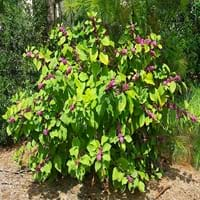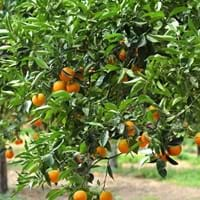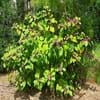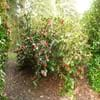What is
Life Span
Perennial
Perennial
Type
Shrub
Fruit
Origin
Southeastern United States, South-Central United States
Southern Asia, India, Melanesia, Australia
Types
Not Available
oranges, grapefruit, lemons
Habitat
bottomlands, Coastal Regions, Moist woods, pine woods, Slopes, Swamps, Thickets, Woods
agricultural areas
USDA Hardiness Zone
6-11
Not Available
AHS Heat Zone
12-1
Not Available
Sunset Zone
3a, 3b, 4, 5, 6, 7, 8, 9, 14, 15, 16, 17, 18, 19, 20, 21, 22, 23, 24
Not Available
Habit
Arching/Fountain-shaped
Oval or Rounded
Information
Plant Size
Minimum Height
182.88 cm
99+
Not Available
Minimum Width
182.88 cm
99+
244.00 cm
99+
Plant Color
Flower Color
Pink, Lavender
White, Purple, Ivory
Flower Color Modifier
Not Available
Bicolor
Fruit Color
Purple, White
Yellow, Red, Green, Orange
Leaf Color in Spring
Light Green
Green, Dark Green
Leaf Color in Summer
Light Green
Green, Dark Green
Leaf Color in Fall
Yellow green, Tan
Green, Dark Green
Leaf Color in Winter
Not Available
Light Green
Shape
Leaf Shape
Elliptic
Toothed
Thorns
No
Yes
Season
Plant Season
Spring, Summer, Fall
Spring, Summer, Fall, Winter
Growing Conditions
Sunlight
Full Sun, Partial Sun, Partial shade
Full Sun, Partial Sun
Growth Rate
Medium
Medium
Type of Soil
Clay, Loam, Sand
Clay, Loam, Sand
The pH of Soil
Acidic, Neutral
Acidic, Neutral, Alkaline
Soil Drainage
Well drained
Well drained
Bloom Time
Early Summer, Summer, Late Summer
Not Available
Repeat Bloomer
No
Not Available
Tolerances
Not Available
Drought
Care
Where to Plant?
Ground, Pot
Ground
How to Plant?
Cuttings, Seedlings
Seedlings, Stem Planting
Plant Maintenance
Medium
Medium
Watering Plants
Watering Requirements
Medium
Keep ground moist
In Summer
Lots of watering
Lots of watering
In Spring
Moderate
Moderate
In Winter
Average Water
Average Water
Soil
Soil pH
Acidic, Neutral
Acidic, Neutral, Alkaline
Soil Type
Clay, Loam, Sand
Clay, Loam, Sand
Soil Drainage Capacity
Well drained
Well drained
Sun Exposure
Full Sun, Partial Sun, Partial shade
Full Sun, Partial Sun
Pruning
No need to prune
Remove damaged leaves, Remove dead branches, Remove dead leaves
Fertilizers
All-Purpose Liquid Fertilizer, fertilize in spring, Use a fertilizer ratio of 16-4-8
All-Purpose Liquid Fertilizer
Pests and Diseases
Red blotch
Red blotch
Plant Tolerance
Not Available
Drought
Facts
Flowers
Yes
Showy
Flower Petal Number
Single
Single
Fruits
Showy Fruit
Yes
Yes
Edible Fruit
No
Yes
Fragrance
Fragrant Flower
Yes
Yes
Fragrant Fruit
No
Yes
Fragrant Leaf
No
Yes
Fragrant Bark/Stem
No
Yes
Showy Foliage
No
No
Showy Bark
No
Yes
Foliage Texture
Coarse
Medium
Foliage Sheen
Matte
Glossy
Evergreen
No
No
Invasive
No
No
Self-Sowing
Yes
Yes
Attracts
Birds, Butterflies
Birds, Butterflies
Allergy
Poisonous
Itchiness, Oral Allergy
Benefits
Uses
Aesthetic Uses
Showy Purposes
Not Available
Beauty Benefits
Not Available
Good for skin and hair, Makes teeth white, Skin cleanser
Edible Uses
Yes
Yes
Environmental Uses
Air purification, Food for animals, Food for birds
Air purification
Plant Benefits
Medicinal Uses
Colic, Dysentry, Fever, Malaria, Rheumatism, Stomach pain
Kidney Stones, scurvy, Stomach Cancer
Part of Plant Used
Flowers, Root
Flowers, Fruits, Leaves
Other Uses
Showy Purposes, Used as Ornamental plant, Used for bedding in gardens, Used for fragrance, Used for its medicinal properties, Used for Landscaping
Not Available
Used As Indoor Plant
No
Yes
Used As Outdoor Plant
Yes
Yes
Garden Design
Foundation, Mixed Border, Screening, Wind Break
Container, Edible, Feature Plant, Fruit / Fruit Tree, Houseplant, Shade Trees, Topiary / Bonsai / Espalier, Tropical
Scientific Name
Botanical Name
CALLICARPA americana
CITRUS
Common Name
American beautyberry , French mulberry
Citrus
In Hindi
American Beautyberry Tree
निम्बू-वंश
In German
Amerikanische Schönbaum
Zitruspflanzen
In French
Américaine Beautyberry Arbre
Citrus
In Spanish
Americana beautyberry Árbol
Citrus
In Greek
American Beautyberry Δέντρο
Citrus
In Portuguese
Árvore Beautyberry Americana
Citrus é um género
In Polish
Amerykański pięknotka Drzewo
Cytrus
In Latin
Latin Beautyberry ligno
citrus
Classification
Kingdom
Plantae
Plantae
Phylum
Magnoliophyta
Magnoliophyta
Class
Magnoliopsida
Magnoliopsida
Order
Lamiales
Sapindales
Family
Verbenaceae
Rutaceae
Genus
Callicarpa
Citrus
Clade
Angiosperms, Asterids, Eudicots
Angiosperms, Eudicots, Rosids
Tribe
Not Available
Citreae
Subfamily
Ranunculoideae
Asteroideae
Number of Species
Not Available
28
99+
|
||
|
||
|












